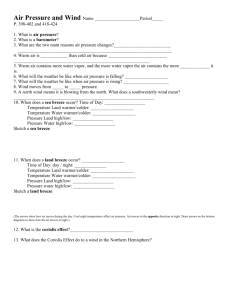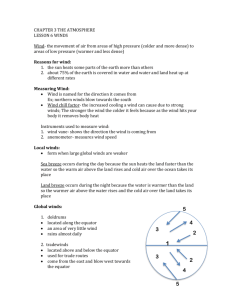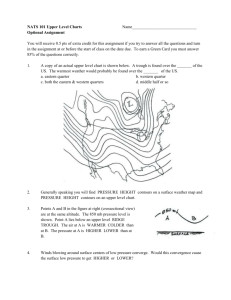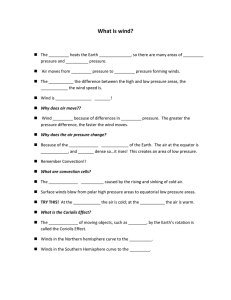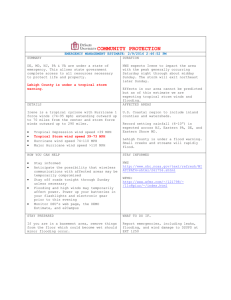21111 Prof. Seiberling PHYSICS DEPARTMENT MET 1010
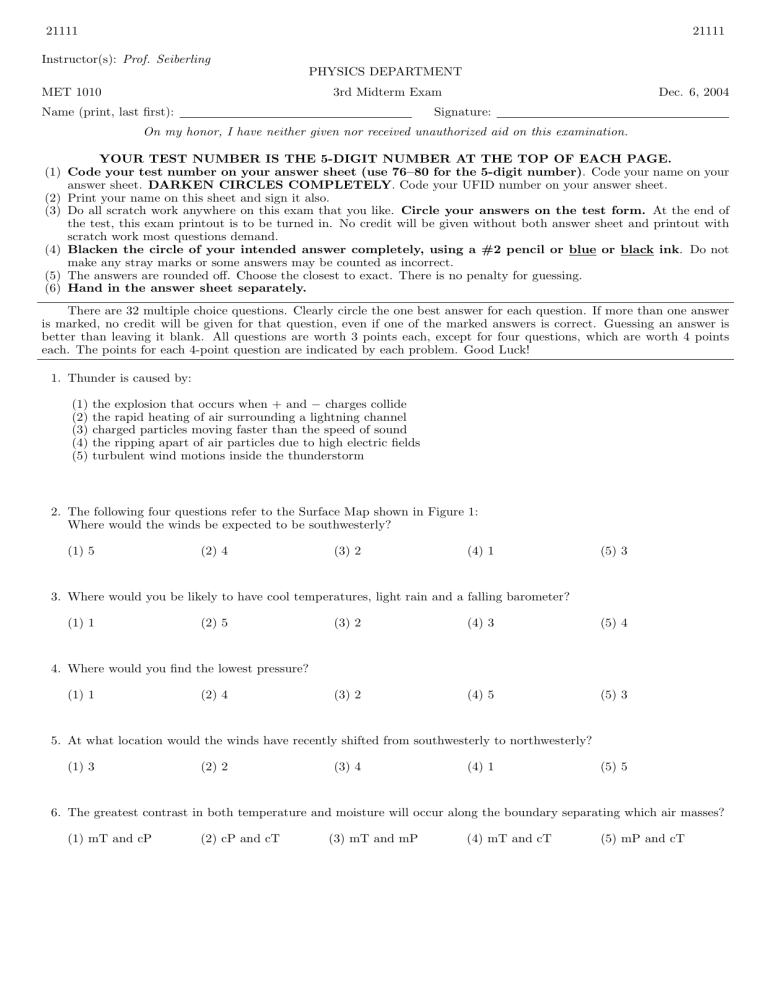
21111 21111
Instructor(s): Prof. Seiberling
MET 1010
PHYSICS DEPARTMENT
3rd Midterm Exam
Name (print, last first): Signature:
On my honor, I have neither given nor received unauthorized aid on this examination.
Dec. 6, 2004
YOUR TEST NUMBER IS THE 5-DIGIT NUMBER AT THE TOP OF EACH PAGE.
(1) Code your test number on your answer sheet (use 76–80 for the 5-digit number) . Code your name on your answer sheet.
DARKEN CIRCLES COMPLETELY . Code your UFID number on your answer sheet.
(2) Print your name on this sheet and sign it also.
(3) Do all scratch work anywhere on this exam that you like.
Circle your answers on the test form.
At the end of the test, this exam printout is to be turned in. No credit will be given without both answer sheet and printout with scratch work most questions demand.
(4) Blacken the circle of your intended answer completely, using a #2 pencil or blue or black ink . Do not make any stray marks or some answers may be counted as incorrect.
(5) The answers are rounded off. Choose the closest to exact. There is no penalty for guessing.
(6) Hand in the answer sheet separately.
There are 32 multiple choice questions. Clearly circle the one best answer for each question. If more than one answer is marked, no credit will be given for that question, even if one of the marked answers is correct. Guessing an answer is better than leaving it blank. All questions are worth 3 points each, except for four questions, which are worth 4 points each. The points for each 4-point question are indicated by each problem. Good Luck!
1. Thunder is caused by:
(1) the explosion that occurs when + and − charges collide
(2) the rapid heating of air surrounding a lightning channel
(3) charged particles moving faster than the speed of sound
(4) the ripping apart of air particles due to high electric fields
(5) turbulent wind motions inside the thunderstorm
2. The following four questions refer to the Surface Map shown in Figure 1:
Where would the winds be expected to be southwesterly?
(1) 5 (2) 4 (3) 2 (4) 1
3. Where would you be likely to have cool temperatures, light rain and a falling barometer?
(1) 1 (2) 5 (3) 2 (4) 3 (5) 4
4. Where would you find the lowest pressure?
(1) 1 (2) 4 (3) 2 (4) 5
(5) 3
(5) 3
5. At what location would the winds have recently shifted from southwesterly to northwesterly?
(1) 3 (2) 2 (3) 4 (4) 1 (5) 5
6. The greatest contrast in both temperature and moisture will occur along the boundary separating which air masses?
(1) mT and cP (2) cP and cT (3) mT and mP (4) mT and cT (5) mP and cT
21111
7. Storms that form in the tropics are given names when:
(1) they reach tropical storm strength
(2) they become fully developed hurricanes
(3) they reach tropical depression strength
(4) rotation becomes visible on a satellite photograph
(5) they approach within 250 miles of land
8. A forecast of an extended period of dry weather would be made for a region beneath:
(1) a shortwave trough
(2) a cold pool of air aloft
(3) the polar jet stream
(4) an upper-level trough
(5) an upper-level ridge
21111
9. Streamlines on a weather map depict:
(1) water temperature (2) wind flow (3) pressure
10. A persistence forecast could be quite accurate when:
(1) you are positioned in the middle of a large, stationary air mass
(2) a frontal system approaches your location at constant speed
(3) upper level winds are zonal
(4) the weather has been unusually cold for several days
(5) upper level winds are meridional
(4) ocean currents (5) dew point
11. The rotating updraft inside a severe thunderstorm is called a:
(1) roll cloud (2) mesohigh (3) suction vortice (4) funnel cloud (5) mesocyclone
12. The instrument that measures the speed at which precipitation is moving toward or away from an observer is:
(1) the radiosonde (2) the Fugita scaler (3) the aerovane (4) Doppler radar (5) the wind psychrometer
13. (4 points) The higher the ratio of oxygen 18 to oxygen 16 in the shells of organisms that lived in the sea during the geologic past, the the climate at that time.
(1) drier (2) more humid (3) colder (4) wetter (5) warmer
14. Which below is the best indication that a hurricane will likely strike your area within 24 hours?
(1) a hurricane warning is issued by the National Weather Service
(2) easterly or northeasterly winds with speeds in excess of 30 knots
(3) a hurricane watch is issued by the National Weather Service
(4) a rapid drop in pressure and heavy rains
(5) high cirrus clouds moving in from the east
21111
15. (4 points) The strongest winds in a hurricane heading north toward Florida would most likely be found on the side.
(1) southwest (2) south (3) north (4) east (5) west
21111
16. Thunderstorms that produce tornadoes:
(1) have very little cloud-to-ground lightning
(2) will not produce hail
(3) generally move toward the southwest
(4) have rotating updrafts
(5) have updraft velocities that exceed 100 mph
17. On what timescale should variations of the climate occur associated with the reversal of the Sun’s magnetic field?
(1) 22 years (2) millions of years (3) 23,000 years (4) 41,000 years (5) 100,000 years
18. (4 points) When does cold advection occur?
(1) during baroclinic conditions as air moves from a warmer to a colder location
(2) at the surface, directly below an area of warm advection
(3) during barotropic conditions as air moves from a warmer to a colder location
(4) during baroclinic conditions as air moves from a colder to a warmer location
(5) during barotropic conditions as air moves from a colder to a warmer location
19. Cumuliform cloud development would be most likely in which of the following?
(1) cT air mass moving over a mountain range
(2) mT air mass moving over cold land surface
(3) cT air mass moving over cold water
(4) cP air mass moving over warm water
(5) cP air mass moving over a mountain range
20. The cold water observed along the northern California coast in summer is mainly due to:
(1) rapid evaporation (2) oceanic fronts (3) upwelling (4) cold air moving over the water (5) the Peru Current
21. In the Northern Hemisphere, hurricanes and middle latitude cyclones are similar in that both:
(1) are favored for development when upper level winds are diverging
(2) intensify with increasing height above the ground
(3) will generally move from west to east
(4) have surface weather fronts
(5) require strong vertical wind shear
21111 21111
22. The next three questions refer to the Map shown in Figure 3. In the Figure, the solid lines are contours at the 500 mb level and the H refers to a high pressure region at 500 mb. The dashed lines are isobars on the Surface Map and the
L refers to a surface low.
Which of the following statements gives the most likely prediction for how the surface low will develop?
(1) The surface low will decrease in strength and move toward the northeast
(2) The surface low will increase in strength and move toward the south
(3) The surface low will increase in strength and move toward the northeast
(4) The surface low will decrease in strength and move toward the south
(5) The surface low will increase in strength and move toward the north
23. (4 points) You are standing at position 1 in the Figure. You would observe surface winds to be winds to be .
and upper-level
(1) westerly, westerly (2) westerly, northerly (3) northerly, westerly (4) easterly, southerly (5) southerly, easterly
24. The winds aloft are blowing at about 60 mph. How fast would you expect the surface low to move?
(1) 15 mph (2) 0 mph (3) 60 mph (4) 45 mph (5) 30 mph
25. Everything else being equal, a gradual increase in global CO
2 would most likely bring about:
(1) no change in global climate
(2) a decrease in surface air temperature
(3) a marked decrease in plant growth
(4) an increase in surface air temperature
(5) a decrease in evaporation from the earth’s oceans
26. If the earth were in a warming trend, which of the processes below would most likely act as a negative feedback mechanism?
(1) increasing the carbon dioxide content of the air
(2) decreasing the amount of cloud cover around the globe
(3) Increasing the snow cover around the earth
(4) increasing the temperature of the oceans
(5) increasing the water vapor content of the air
27. Over the past 100 years or so, it appears that average global temperatures have:
(1) increased by less than 1 ◦
(2) remained constant
C
(3) fluctuated widely, but shown no overall change
(4) increased by as much as 6 ◦ C
(5) decreased slightly
28. Hurricanes do NOT form:
(1) when the trade wind inversion is weak
(2) when the surface water temperature exceeds 25 ◦ C
(3) along the ITCZ
(4) along the equator
(5) with an easterly wave
21111
29. The following four questions refer to the 500 mb Chart shown in Figure 2:
A developing wave cyclone would most likely be found below:
(1) 2 (2) 1 (3) 4 (4) 5
(4) 3
(5) 3
(5) 5
21111
30. A person at the earth’s surface directly beneath position 2 would observe clouds overhead (at the 500 mb level) moving from:
(1) southeast to northwest (2) northwest to southeast (3) west to east (4) east to west (5) northeast to southwest
31. A surface high pressure area moving toward the southeast would most likely be found beneath point:
(1) 1 (2) 4 (3) 2 (4) 3 (5) 5
32. The area of maximum vorticity would be found at position:
(1) 2 (2) 1 (3) 4
21111 21111
21111 21111
